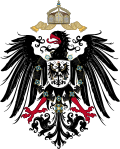| House Order of the Wendish Crown | |
|---|---|
 Badge of the Order | |
| Awarded by the House of Mecklenburg | |
| Type | House Order |
| Royal house | House of Mecklenburg |
| Ribbon | Light blue with inner yellow and outer red side stripes |
| Motto | Per aspera ad astra |
| Status | Currently constituted [1] |
| Head | Borwin, Duke of Mecklenburg |
| Precedence | |
| Next (higher) | Order of the Griffon |
| Ribbon of the Order | |
The House Order of the Wendish Crown (German : Hausorden der Wendischen Krone) is a dynastic order that was jointly instituted on 12 May 1864 by Grand Duke Friedrich Franz II of Mecklenburg-Schwerin and Grand Duke Friedrich Wilhelm of Mecklenburg-Strelitz. It is the oldest and most senior order of the House of Mecklenburg. [2]

